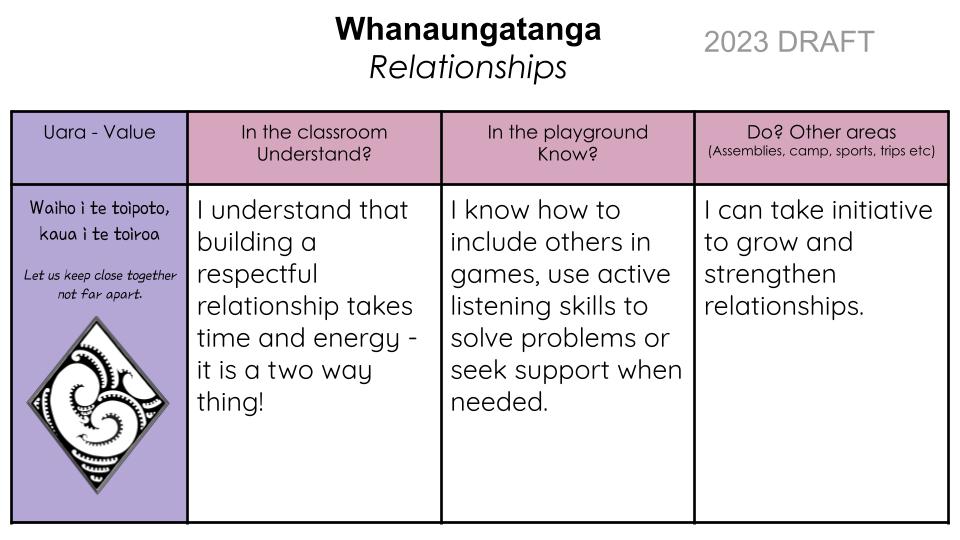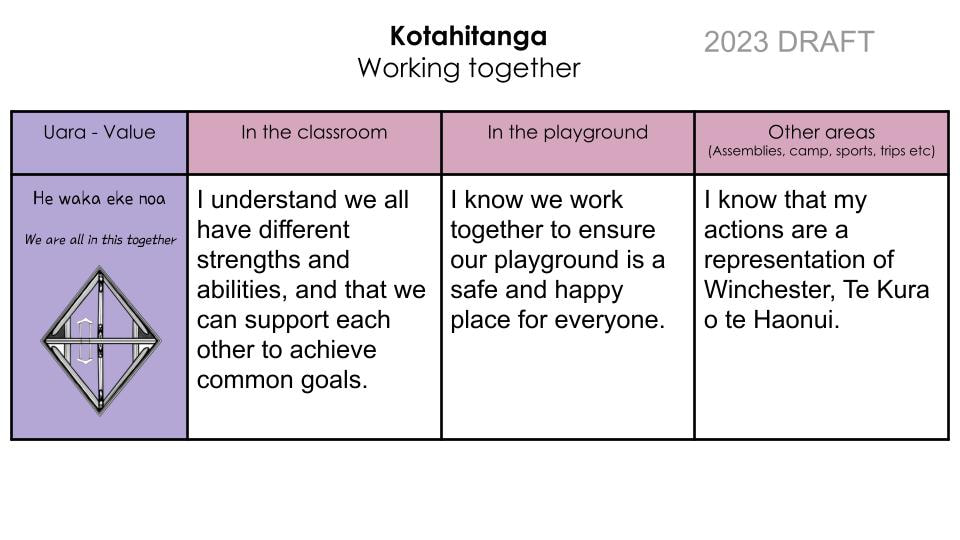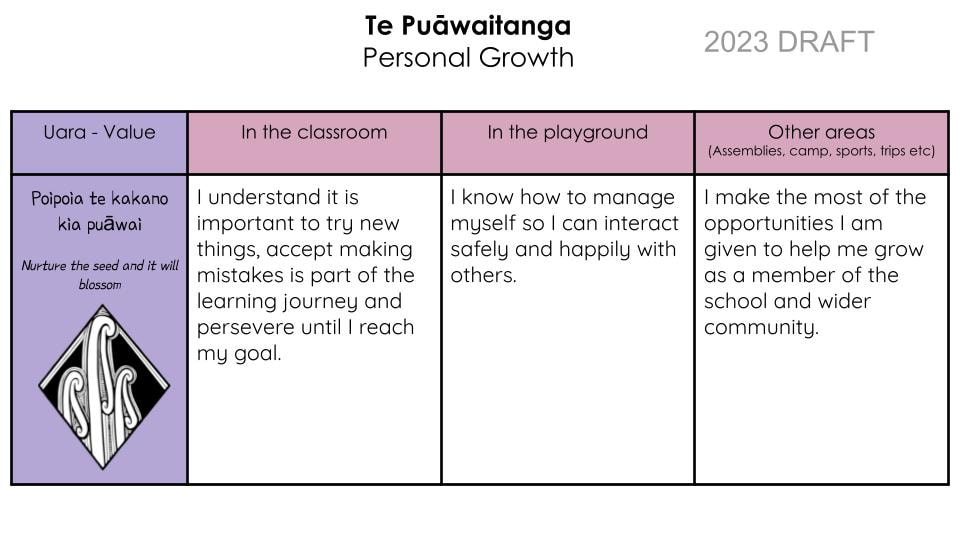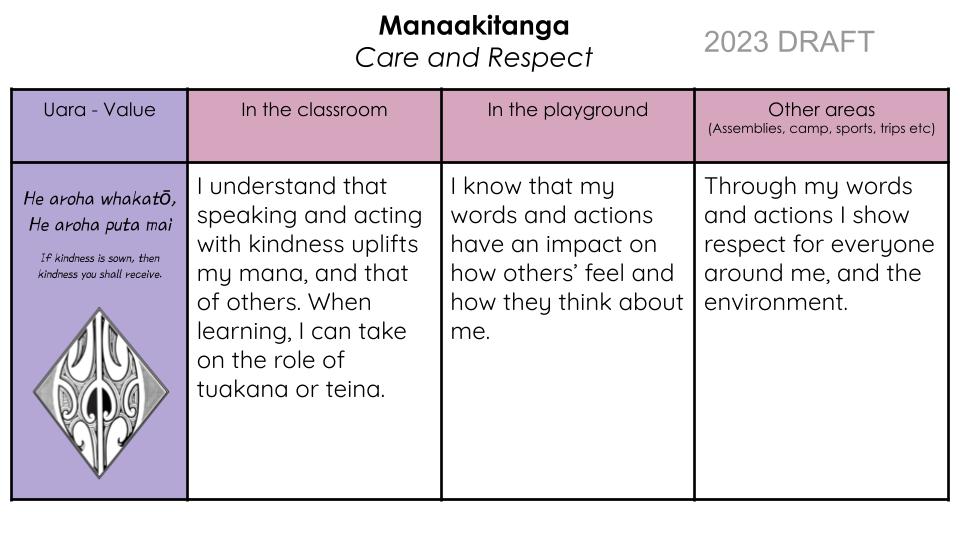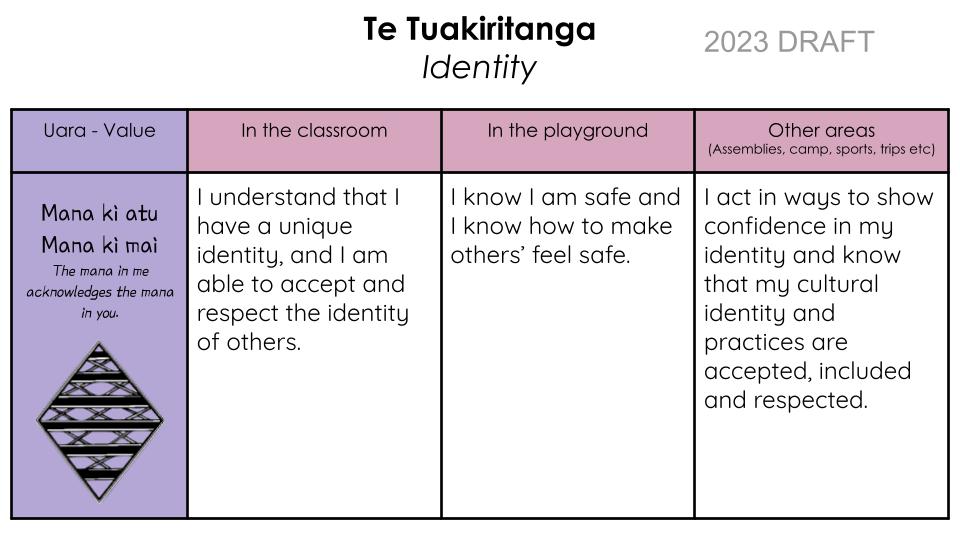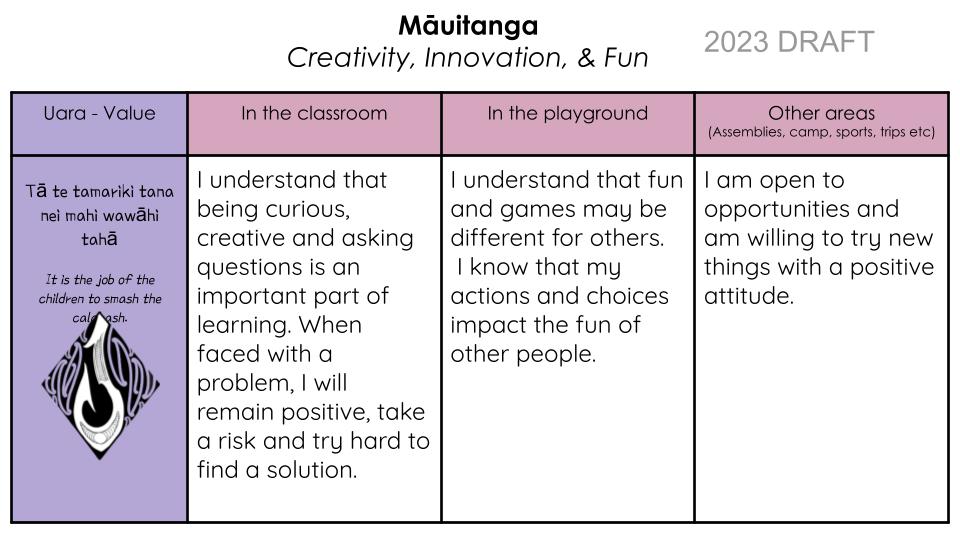Winchester School Te Kura o Te Haonui have adopted 6 uara or values. These were values that were already present in our school and community and through consultation with iwi and our Māori whānau we developed the following names.
In 2023, we have worked through each value/uara to create three essence statements in line with "Understand", "Know", "Do".
Here are some indicators of our ākonga/learners showing our school values in action and receiving a Right choice ticket.
In 2023, we have worked through each value/uara to create three essence statements in line with "Understand", "Know", "Do".
Here are some indicators of our ākonga/learners showing our school values in action and receiving a Right choice ticket.
Our Right choice programme looks through the lens of our Ngā Uara (Values) and ākonga/learners will be recognised in the following ways:
- Individual Right Choice Recognition: Ākonga/learners receive a 'Right Choice' when demonstrating our values, reinforcing positive behaviour. Good choices are also recognised through Principal's Awards and Team Certificates.
- Class Right Choice Recognition: Classes work towards a Class Right Choice Reward when they receive a certain amount of Right Choice tickets. The amount will vary depending on the age of the class. Class rewards could be a class game, free choice time etc.
- School Right Choice Recognition: The whole school works towards a school reward e.g. filling up the Right Choice Bucket. Some examples of school rewards could be:
- School based: Terms 1&3 Water Play, Discovery Time, Juices/Pizza, Movie Day, Sports Day
- Outside of School based: Memorial Park, The Lido, Esplanade.
When things go wrong...
Winchester School Te Kura o Te Haonui uses Restorative Practice to solve conflict when it arrises.
Why Restorative?
Winchester School Te Kura o Te Haonui believes in the mana of relationships. We are a school built on positive relationships (whanaungatanga). Therefore, using restorative conversations is in line with our beliefs because a restorative approach focuses on repairing harm. It ensures that the relationship between learner to learner has been restored. Whereas a punitive approach focuses on punishing the offence where one is punished according to the rule they broke.
What is a restorative conversation?
Restorative conversations allow the teacher to demonstrate empathy, teach children how to resolve conflict, and most importantly, allow students to have a voice. It's an opportunity for both the teacher and student to express their feelings about what's going on in the classroom while setting high expectations.
‘Whangaia ka tupu, ka puāwai’ 'That which is nurtured, blossoms and grows’
Behaviour Management: Right Choice Winchester School Te Kura o Te Haonui
Our school provides a safe physical and emotional environment for students and staff.
Managing behaviour relies on consistently applying both our school's behaviour plan and strategies to promote positive student behaviour. We also expect high standards of conduct from our school community, which includes modelling good behaviour for students.
At Winchester School Te Kura o Te Haonui:
- Staff, including relievers, coaches, and tutors etc, maintain positive learning environments and relationships with students.
- We make a clear statement of acceptable and unacceptable behaviour known to all staff, parents, and students.
- All members of the school, including the students themselves, have a responsibility to recognise bullying and to take action when they are aware of it happening.
- We consistently apply our behaviour management strategies in all cases of unacceptable behaviour, and endeavour to maintain the dignity of the student at all times.
- Staff manage challenging behaviour and use de-escalation techniques if a student's behaviour is becoming out of control and/or poses a danger to themselves or others. Physical restraint is used only in an emergency situation, and only according to our physical restraint guidelines.
- The school actions the procedures outlined by the Ministry of Education for the stand-down, suspension, or exclusion of students, in cases of extreme and persistent behaviour.
- Individual programmes and strategies for students with particular behaviour difficulties are devised with parents and staff, and outside agencies if necessary, and these students may be dealt with outside the school's behaviour plan.
- Seclusion and corporal punishment are not used at this school. See Care and Management of Students.
At Winchester School Te Kura o Te Haonui, everyone has the right to feel safe, be respected and learn. We actively teach our learners to make the right choices through our ngā uara/values. To help us develop respect for others, ourselves and our environment we have developed a set of guidelines that we live by.
Consequences - How we will manage challenging behaviours:
Note: Learners with special needs or trauma will require individualised or differentiated strategies and plans.
Winchester School Te Kura o Te Haonui uses Restorative Practice to solve conflict when it arrises.
Why Restorative?
Winchester School Te Kura o Te Haonui believes in the mana of relationships. We are a school built on positive relationships (whanaungatanga). Therefore, using restorative conversations is in line with our beliefs because a restorative approach focuses on repairing harm. It ensures that the relationship between learner to learner has been restored. Whereas a punitive approach focuses on punishing the offence where one is punished according to the rule they broke.
What is a restorative conversation?
Restorative conversations allow the teacher to demonstrate empathy, teach children how to resolve conflict, and most importantly, allow students to have a voice. It's an opportunity for both the teacher and student to express their feelings about what's going on in the classroom while setting high expectations.
‘Whangaia ka tupu, ka puāwai’ 'That which is nurtured, blossoms and grows’
Behaviour Management: Right Choice Winchester School Te Kura o Te Haonui
Our school provides a safe physical and emotional environment for students and staff.
Managing behaviour relies on consistently applying both our school's behaviour plan and strategies to promote positive student behaviour. We also expect high standards of conduct from our school community, which includes modelling good behaviour for students.
At Winchester School Te Kura o Te Haonui:
- Staff, including relievers, coaches, and tutors etc, maintain positive learning environments and relationships with students.
- We make a clear statement of acceptable and unacceptable behaviour known to all staff, parents, and students.
- All members of the school, including the students themselves, have a responsibility to recognise bullying and to take action when they are aware of it happening.
- We consistently apply our behaviour management strategies in all cases of unacceptable behaviour, and endeavour to maintain the dignity of the student at all times.
- Staff manage challenging behaviour and use de-escalation techniques if a student's behaviour is becoming out of control and/or poses a danger to themselves or others. Physical restraint is used only in an emergency situation, and only according to our physical restraint guidelines.
- The school actions the procedures outlined by the Ministry of Education for the stand-down, suspension, or exclusion of students, in cases of extreme and persistent behaviour.
- Individual programmes and strategies for students with particular behaviour difficulties are devised with parents and staff, and outside agencies if necessary, and these students may be dealt with outside the school's behaviour plan.
- Seclusion and corporal punishment are not used at this school. See Care and Management of Students.
At Winchester School Te Kura o Te Haonui, everyone has the right to feel safe, be respected and learn. We actively teach our learners to make the right choices through our ngā uara/values. To help us develop respect for others, ourselves and our environment we have developed a set of guidelines that we live by.
Consequences - How we will manage challenging behaviours:
- describe the behaviour and rule reminder - "you're running inside, at Winchester School we move sensibly around the school."
- repeated behaviour - speak in private about the behaviour, describe the behaviour and give a clear verbal warning.
- behaviour continued - a private conversation once all parties are calm; have a restorative conversation and agree on an appropriate consequence to the behaviour e.g. cleaning up, apology, active teaching (time-in), reflection (time-out), removal of privileges etc; teacher to make contact with parents and team leaders.
- serious physical or verbal behaviour, including cyber bullying go straight to bullet point 3; inform senior leadership: AP or DP.
- all parties (parent, teacher, child and leadership) come together to form a plan around the behaviour; monitor and adapt as you go.
Note: Learners with special needs or trauma will require individualised or differentiated strategies and plans.


